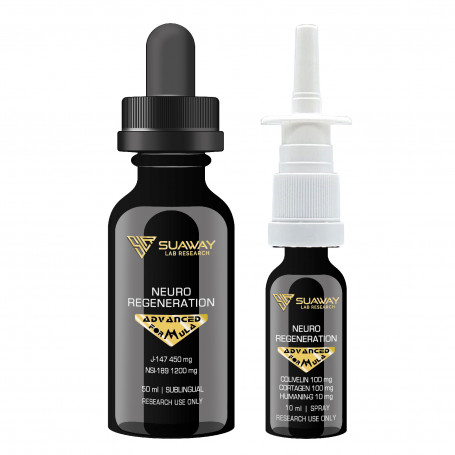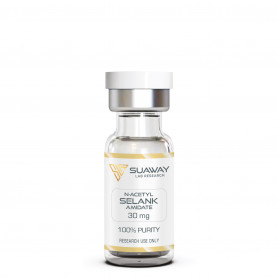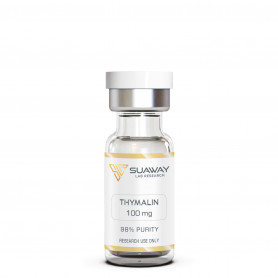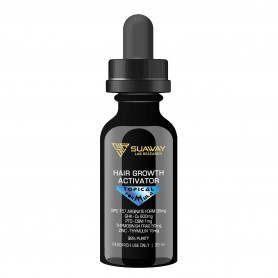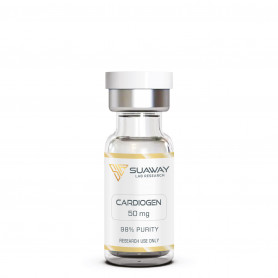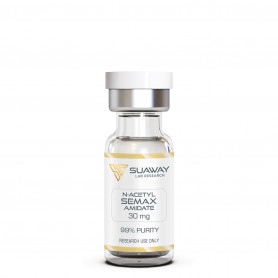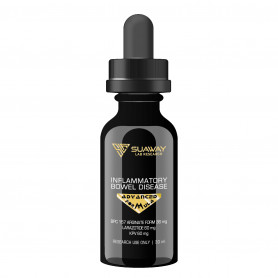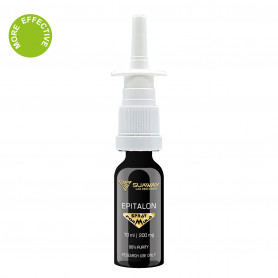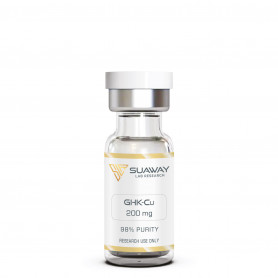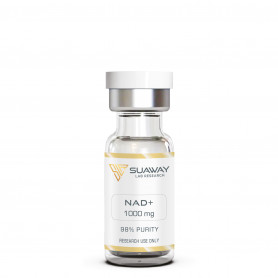NEURO REGENERATION - 10ml+30ml
NEURO REGENERATION - ADVANCED FORMULA
10 ml Nasal Spray: Colivelin 100 mg; Cortagen 100 mg; Humanin G 10 mg. Total Spray: 82. Per Spray: Colivelin 1219 mcg, HNG 121 mcg, Cortagen 1219 mcg.
30 ml Sublingual: J-147 450 mg; NSI-189 1200 mg. 1 ml (approximately 20 drops): J-147 15 mg; NS-189 40 mg.
- Improves memory
- Inhibits cell death
- Stimulates the cerebral reparative processes
- Increases BDNF levels in the hippocampus
- Reduces AB accumulation
- Neuroprotective
- Neurotrophic
- Improves mitochondrial levels of Glutathione (GSH)
- Protects cells from oxidative stress
- Degrades atherosclerotic plaques
- Lowers inflammation
- Suppresses hypoxia
FRESHLY PREPARED SOLUTION
Beschreibung
STRUCTURE
COLIVELIN
Sequence: H-Ser-Ala-Leu-Leu-Arg-Ser-Ile-Pro-Ala-Pro-Ala-Gly-Ala-Ser-Arg-Leu-Leu-Leu-Leu- Thr-Gly-Glu-Ile-Asp-Leu-Pro-OH
Molecular Formula: C119H206N32O35
Molecular Weight: 2645.13 g/mol
CAS: 867021-83-8
Peptide Purity: Greater than 98%
Other details: No TFA Salt, No Mannitol
CORTAGEN
Sequence: L-Ala-L-Glu-L-Asp-L-Pro
Molecular Formula: C17H26N4O9
Molecular Weight: 430.41 g/mol
Peptide purity: Greater than 98%
Other details: No TFA Salt, No Mannitol
HUMANIN G
HNG (Humanin-G) is an analog of Humanin, generated by S14G (serine-14-glycine)
Sequence: H-Met-Ala-Pro-Arg-Gly-Phe-Ser-Cys-Leu-Leu-Leu-Leu-Thr-Gly-Glu-Ile-Asp-Leu-Pro-Val-Lys-Arg-Arg-Ala-O H
Molecular Formula: C118H202N34O31S2
Molecular Weight: 2657,3 g/mol
CAS: 330936-70-4
Peptide Purity: Greater than 98%.
Other details: No TFA Salt, No Mannitol
J-147
2,2,2-Trifluoroacetic acid 1-(2,4-Dimethylphenyl)-2-[(3-methoxyphenyl)methylene]hydrazide
Molecular Formula: C18H17F3N2O2
Molecular Weight: 350.33 g/mol
CAS: 1146963-51-0
Purity: Greater than 99%
NSI-189 PHOSPHATE
(2-((3-Methylbutyl)amino)-3-pyridinyl)(4-(phenylmethyl)-1-piperazinyl)-methanone phosphate
Molecolar Formula: C22H33N4O5P
Molecular Weight: 464.5 g/mol
CAS: 1270138-41-4
Purity: Greater than 99%
DESCRITPION
COLIVELIN
Colivelin is a brain penetrant neuroprotective peptide and a potent activator of STAT3, suppresses neuronal death by activating STAT3 in vitro.
Colivelin exhibits long-term beneficial effects against neurotoxicity, Aβ deposition, neuronal apoptosis, and synaptic plasticity deficits in neurodegenerative disease. Colivelin has the potential for the treatment of alzheimer's disease and ischemic brain injury.
This hybrid peptide was synthesized to potentiate the neuroprotective effect of humanin (HN). Colivelin is composed of Activity-Dependent Neurotrophic Factor (ADNF) C-terminally fused to AGA-(C8R) HNG17, a potent HN derivative.
Colivelin completely suppresses cell death induced by overexpressed Familial Alzheimer's disease (FAD)-causative genes and beta-amyloid. Colivelin administration decreased the neurological deficits and infarct lesion induced by brain ischemia.
Colivelin inhibited axonal damage and neuronal death in brain tissue, which was associated with elevated anti-apoptotic gene expression in ischemic neurons as well as increased axonal growth up until two-weeks post-stroke.
Moreover, Colivelin activated STAT3 signaling, which may partially contribute to its beneficial effect against neuronal death and axon growth. In conclusion, Colivelin induce anti-apoptotic genes up-regulation, and activate JAK/STAT3 signaling after ischemic stroke, which may contribute to its effects of rescuing ischemic neuronal death and axonal remodeling.
CORTAGEN
Synthetic tetrapeptide Cortagen was obtained by directed synthesis based on amino acid analysis of natural brain cortex peptide preparation Cortexin. Previously, Cortagen had demonstrated a pronounced therapeutic effect upon the structural and functional posttraumatic recovery of peripheral nerve tissue, while Cortexin have demonstrated its effect upon cardiovascular and cerebrovascular parameters in human patients. According to the recent report, Cortagen significantly up-regulated interleukin-2 (IL-2) gene expression in mouse splenocytes.
Application of Cortagen accelerated the restoration of various important functional indices in the nerve regenerating after compression. At that, the tetrapeptide stimulated regeneration both in the nerve and in the muscle and approximating them to the state characteristic for intact “healthy” motional units.
Thus, after the performed experiments Cortagen was found to be non-toxic, able to stimulate activity of the cerebral neurones manifested in a marked cerebroprotective action, metabolic activation and high neurotropic activity.
Cortagen can be employed as a drug stimulating cerebral reparative processes and revealing cerebroprotective activity, as an agent for:
- Treatment and prevention of trauma-associated cerebral lesions;
- Treatment for the cerebral lesions after poisoning with therapeutic agents, medicinal and biological compounds;
- Treatment and prevention of pediatric cerebral degenerative disorders;
- Treatment and prevention of Alzheimer's disease, Pick's disease, senile cerebral degeneration and hydrocephalus;
- Treatment and prevention of Parkinson's disease and other extra pyramidal disorders (degenerative diseases of basal ganglia, essential tremor, myoclonus, tics of organic origin, Huntington's chorea);
- Treatment and prevention of spinal-cerebellum disorders (Friedrich's ataxia, hereditary spastic paraplegia and cerebellum ataxia in other disorders);
- Treatment and prevention of senile dementia including that concomitant to Alzheimer's disease, Jacob-Creutzfeldt disease and Pick's disease;
- Treatment and prevention of dementia in case of various disorders (HIV-encephalopathy, epilepsy, syphilis, multiple sclerosis and polyarteritis nodosa);
- Treatment and prevention of infantile cerebral paralysis;
- Treatment and prevention of other paralytic syndromes (quadriplegia, paraplegia, diplegia of upper extremities, monoplegia of lower extremities);
- Treatment and prevention of cerebral impairments in case of bacterial meningitis including cryptococcus meningitis in AIDS patients;
- Treatment and prevention of cerebral impairments in case of non-bacterial meningitis;reatment and prevention of cerebral impairments in case of meningitis of unclear origin;
- Treatment and prevention of cerebral impairments in case of encephalitis, myelitis and encephalomyelitis, including cerebral toxoplasmosis in AIDS patients;
- Treatment and prevention of cerebral impairments in case of cerebral haemorrhage;
- Treatment and prevention of cerebral impairments in case of transitory cerebral ischemia;
- Treatment and prevention of delirium tremens at abstinence syndrome;
- Treatment and prevention of alcoholic amnestic syndrome and other alcoholic dementia disorders;
- Treatment and prevention of pathologic alcoholic intoxication;
- Treatment and prevention of the drug abstinence syndrome;
- Treatment and prevention of aphasia and apraxia;
Clinical application of Cortagen confirmed the experimental data on the effectiveness of the said agent in diseases and disorders caused by or associated with the damage or loss of cerebral neurones.
HUMANIN G
Humanin (HN) is 24-amino acid mitochondria-associated peptide. Serine at position 14 confers neuroprotection, but its substitution with glycine generates a variant called Humanin G (HNG) that is 1000-fold more potent than its parent analog Humanin.
Since its initial discovery over a decade ago, a role for HN has been reported in many biological processes such as apoptosis, cell survival, substrate metabolism, inflammatory response, and response to stressors such as oxidative stress, ischemia, and starvation. HN and its potent analogs have been shown to have beneficial effects in many age-related diseases including Alzheimer’s disease, stroke, diabetes, myocardial ischemia and reperfusion, atherosclerosis, amyotrophic lateral sclerosis, and certain types of cancer both in vitro and in vivo. More recently, an association between HN levels, growth hormone/insulin-like growth factor-1 (GH/IGF axis), and life span was demonstrated using various mouse models with mutations in the GH/IGF axis.
Humanin G can protect brain cells against Amyloid-Beta (AB)-induced cell death and increase clearance AB levels, a common pathology seen Alzheimer's Disease (AD).
The Benefits of Humanin G:
- Protects the brain against Tau Hyperphosphorylation (a pathology of AD);
- Improves memory;
- Reduces AB accumulation and ameliorates memory deficit;
- May protect against Insulin Resistance (IR) in the brain, a main pathology of Type 3 Alzheimer's/Diabetes;
- In the hippocampus, HNG can improve Autophagy by regulating IRS-1/mTOR signaling;
- Provides neuroprotection against some Familial Alzheimer's Disease (FAD) genes including presenilin 1, presenilin 2, and mutated Amyloid Precursor Protein (APP);
- Inhibits Cytochrome C release from mitochondria and can increase their production of energy (ATP);
- Improves mitochondrial levels of Glutathione (GSH);
- Protects cells from oxidative stress;
- Degrades atherosclerotic plaques;
- Lowers inflammation;
- Suppresses hypoxia;
- Inhibits cell death
J-147
J-147 is a potent neuroprotective and neurotrophic compound that protects against neurotoxicity in cortical neurons in vitro (EC₅₀ = 25 - 200 nM). Reduces soluble Aβ40 an Aβ42 levels and increases BDNF levels in the hippocampus in vivo.
J-147 has been shown to enhance memory in normal animals and to prevent memory deficits in an Alzheimer’s disease mouse model. These effects are associated with an increase in brain derived neurotrophic factor levels, enhanced long-term potentiation, preservation of synaptic proteins, a reduction of markers for oxidative stress and inflammation, a reduction of amyloid plaques, and lower levels of soluble amyloid β.
"J147 is an exciting new compound because it really has strong potential to be an Alzheimer's disease therapeutic by slowing disease progression and reversing memory deficits following short-term treatment," says lead study author Marguerite Prior, a research associate in Salk's Cellular Neurobiology Laboratory.
J147 was developed at Salk in the laboratory of David Schubert, a professor in the Cellular Neurobiology Laboratory. He and his colleagues bucked the trend within the pharmaceutical industry, which has focused on the biological pathways involved in the formation of amyloid plaques, the dense deposits of protein that characterize the disease. Instead, the Salk team used living neurons grown in laboratory dishes to test whether their new synthetic compounds, which are based upon natural products derived from plants, were effective at protecting brain cells against several pathologies associated with brain aging. From the test results of each chemical iteration of the lead compound, they were able to alter their chemical structures to make them much more potent. Although J147 appears to be safe in mice, the next step will require clinical trials to determine whether the compound will prove safe and effective in humans.
To test the efficacy of J147 in a much more rigorous preclinical Alzheimer's model, the Salk team treated mice using a therapeutic strategy that they say more accurately reflects the human symptomatic stage of Alzheimer's. Administered in the food of 20-month-old genetically engineered mice, at a stage when Alzheimer's pathology is advanced, J147 rescued severe memory loss, reduced soluble levels of amyloid, and increased neurotrophic factors essential for memory, after only three months of treatment.
Prior and her colleagues say that several cellular processes known to be associated with Alzheimer's pathology are affected by J147, including an increase in a protein called brain-derived neurotrophic factor (BDNF), which protects neurons from toxic insults, helps new neurons grow and connect with other brain cells, and is involved in memory formation. Postmortem studies show lower than normal levels of BDNF in the brains of people with Alzheimer's.
Because of its broad ability to protect nerve cells, the researchers believe that J147 may also be effective for treating other neurological disorders, such as Parkinson's disease, Huntington's disease and amyotrophic lateral sclerosis (ALS), as well as stroke, although their study did not directly explore the drug's efficacy as a therapy for those diseases.
NSI-189 PHOSPHATE
NSI-189 is a neurological and nootropic research and experimental benzylpiperazine-aminopyridine developed by Neuralstem, Inc. NSI-189 is an agent derived from pyrazine and nicotinamide. Studies from randomised and controlled trials have indicated that NSI-189 stimulates neuronal cell production (neurogenesis). In animal controlled trials it has been found that NSI-189 increases hippocampal volume by close to 20% hence not only curbing but also reversing behavioural symptoms of depression.
The hippocampus area of the brain is in charge of spatial control and consolidation of short-term memory to long-term memory. In other words, NSI-189 phosphate aims to improve mood by stimulating the growth of new neurons in the hippocampus.
NSI-189’s mechanism of action remains a trade secret, but it has been speculated that it works by binding to the glucocorticoid receptor. Binding the glucocorticoid receptor can result in a decrease in the circulation of cortisol. Cortisol is an adrenal hormone, specifically a stress hormone, often associated with regulating body changes in response to stress. It is also often associated with a majority of stress-related neuropsychiatric conditions and depression.
The idea behind NSI-189 phosphate is that it can alleviate depression, treat post-traumatic stress disorder, take care of age-related cognitive conditions, and treat Alzheimer’s disease, as well as counter and reverse symptoms seen in disorders such as MDD.
The reason why NSI-189 phosphate has the potential to become a game changer in the medicinal world is that trials have revealed that NSI-189 phosphate addresses three significant factors, including neurogenesis, neurotransmission, and hippocampal volume. Therefore, it has the potential to help promote healthy cell density thus enhancing cognitive performance, facilitate healthy growth of new neuron cells, improve the functionality of neuron cells, and repair damaged areas of the brain.
.
REFERENCES
https://www.nature.com/articles/1301591
https://pubmed.ncbi.nlm.nih.gov/17928813
https://pubmed.ncbi.nlm.nih.gov/16958985
https://www.jneurosci.org/content/25/44/10252
https://alz-journals.onlinelibrary.wiley.com/doi/full/10.1016/j.jalz.2008.05.1405
https://pubmed.ncbi.nlm.nih.gov/31374230
https://onlinelibrary.wiley.com/doi/abs/10.1002/hipo.22378
https://www.pnas.org/content/98/11/6336.long
https://www.sciencedirect.com/science/article/abs/pii/S0024320512003700?via%3Dihub
https://onlinelibrary.wiley.com/doi/10.1002/jcp.20672
https://www.sciencedirect.com/science/article/abs/pii/S0304394002001994?via%3Dihubd
https://jme.bioscientifica.com/view/journals/jme/50/1/R11.xml
https://www.sciencedirect.com/science/article/abs/pii/S0196978103001062?via%3Dihub
https://longevityandhealthspan.biomedcentral.com/articles/10.1186/2046-2395-3-6
https://www.hindawi.com/journals/jst/2012/646354/
https://www.sciencedirect.com/science/article/abs/pii/S0006291X13013922?via%3Dihub
https://pubmed.ncbi.nlm.nih.gov/28726777
https://benthamopen.com/ABSTRACT/TONEUROPPJ-2-22
https://pubmed.ncbi.nlm.nih.gov/15159690
https://benthamopen.com/contents/pdf/TONEUROPPJ/TONEUROPPJ-2-22.pdf
https://patents.justia.com/patent/7189701
https://patents.google.com/patent/US7189701
DISCLAIMER
This product is intendend for lab research and development use only. These studies are performed outside of the body. This product is not medicines or drugs and has not been approved by the FDA or EMA to prevent, treat or cure any medical condition, ailment or disease. Bodily introduction of any kind into humans or animals is strictly forbidden by law. This product should only be handled by licensed, qualified professionals.
All product information provided on this website is for informational and educational purposes only.

